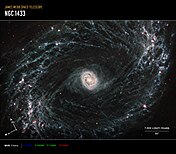NGC 1433
| NGC 1433 | |
|---|---|
 | |
| Observation data (J2000 epoch) | |
| Constellation | Horologium |
| Right ascension | 03h 42m 01.553s[2] |
| Declination | −47° 13′ 19.49″[2] |
| Redshift | 0.003590[2] |
| Heliocentric radial velocity | 1076±1 km/s[3] |
| Distance | 46.2 ± 3.8 Mly (14.15 ± 1.15 Mpc)[4] |
| Apparent magnitude (V) | 9.99[2] |
| Apparent magnitude (B) | 10.84[2] |
| Characteristics | |
| Type | (R'_1)SB(rs)ab [3] |
| Apparent size (V) | 6.5′ × 5.9′[3] |
| Other designations | |
| HIPASS J0342-47, QDOT B0340269-472245, [CHM2007] LDC 266, J034201.55-4713194, AM 0340-472, IRAS 03404-4722, SGC 034027-4722.8, [VDD93] 31, 6dFGS gJ034201.5-471319, LEDA 13586, SINGG HIPASS J0342-47, ESO 249-14, 2MASX J03420155-4713194, [A81] 034029-4724, ESO-LV 249-0140, PSCz Q03404-4722, [CHM2007] HDC 257 J034201.55-4713194 | |
NGC 1433 (also known as PGC 13586) is a barred spiral galaxy with a double ring structure located in the constellation of Horologium. It was discovered by James Dunlop on 28 September 1826,[5] and lies a distance of 46 million light-years from Earth.[4]
NGC 1433 is a Seyfert galaxy with an active galactic nucleus. The central region of the galaxy displays intense star formation activity, with an irregular star-forming ring of 5″ (or 0.3 kpc) radius and weak radio wave emission. Star formation is also noticeable in the spiral arms but not the bar of the galaxy.[6] NGC 1433 is being studied as part of a survey of 50 nearby galaxies known as the Legacy ExtraGalactic UV Survey (LEGUS).[7] A jet of material flowing away from the central black hole of the galaxy extending for only 150 light-years has been found. It is the smallest molecular outflow ever observed in a galaxy beyond our own.[8]
One supernova has been observed in NGC 1433. SN 1985P (type II, mag. 13.5) was discovered by Robert Evans on 10 October 1985.[9][10][11]
NGC 1433 is member of the Dorado Group.[4][12]
Gallery
- LEGUS, optical.[8]
- Hubble Space Telescope, optical.
- STSci DSS, optical.
- James Webb Space Telescope, MIRI; compass.
References
- ^ "ALMA Probes Mysteries of Jets from Giant Black Holes". ESO Press Release. Retrieved 18 October 2013.
- ^ a b c d e "Search Results for NGC 1433". Astronomical Database. SIMBAD. Retrieved 18 October 2013.
- ^ a b c "NASA/IPAC Extragalactic Database". Results for NGC 1433. Retrieved 2016-01-18.
- ^ a b c Tikhonov, N. A.; Galazutdinova, O. A. (2020). "Distance to the Dorado Group". Astrophysical Bulletin. 75 (4): 384–393. arXiv:2009.04090. Bibcode:2020AstBu..75..384T. doi:10.1134/S199034132004015X. S2CID 221556782.
- ^ Seligman, Courtney. "New General Catalogue Objects: NGC 1433". Celestial Atlas. Retrieved 25 November 2024.
- ^ Beck, R.; Shoutenkov, V.; Ehle, M.; Harnett, J. I.; Haynes, R. F.; Shukurov, A.; et al. (August 2002). "Magnetic fields in barred galaxies. I. The atlas" (PDF). Astronomy and Astrophysics. 391: 83–102. arXiv:astro-ph/0207201. Bibcode:2002A&A...391...83B. doi:10.1051/0004-6361:20020642. S2CID 14749261.
- ^ "Legacy ExtraGalactic UV Survey (LEGUS site)". website. Retrieved 21 Oct 2016.
- ^ a b "A galaxy with a glowing heart". ESA/Hubble Picture of the Week. Retrieved 8 August 2014.
- ^ Evans, R. O.; Thompson, G. (1985). "Supernova 1985P in NGC 1433". International Astronomical Union Circular (4119): 2. Bibcode:1985IAUC.4119....2E.
- ^ Chalabaev, A. A.; Cristiani, S. (1987). "Spectroscopy and Photometry of a Type-II Supernova 1985P in NGC1433". European Southern Observatory Conference and Workshop Proceedings. 26: 655. Bibcode:1987ESOC...26..655C.
- ^ "SN 1985P". Transient Name Server. IAU. Retrieved 5 December 2024.
- ^ "ALMA observations of feeding and feedback in nearby Seyfert galaxies: an AGN-driven outflow in NGC 1433" (PDF). Manuscript no. nugas1. Astronomy & Astronophysics. Retrieved 18 October 2013.
External links
 Media related to NGC 1433 at Wikimedia Commons
Media related to NGC 1433 at Wikimedia Commons

![LEGUS, optical.[8]](Https://upload.wikimedia.org/wikipedia/commons/thumb/c/c3/A_galaxy_with_a_glowing_heart.jpg/176px-A_galaxy_with_a_glowing_heart.jpg)


